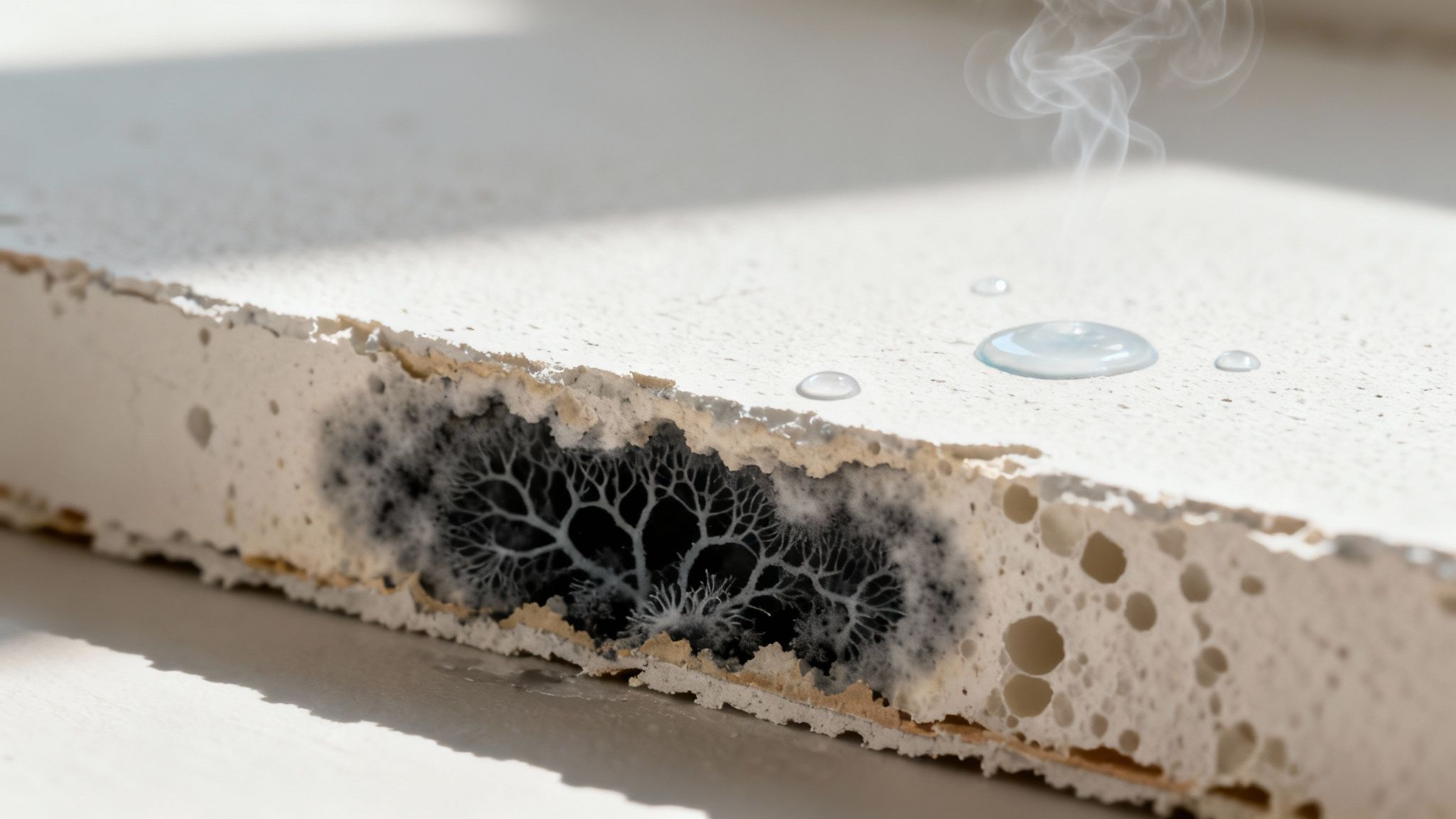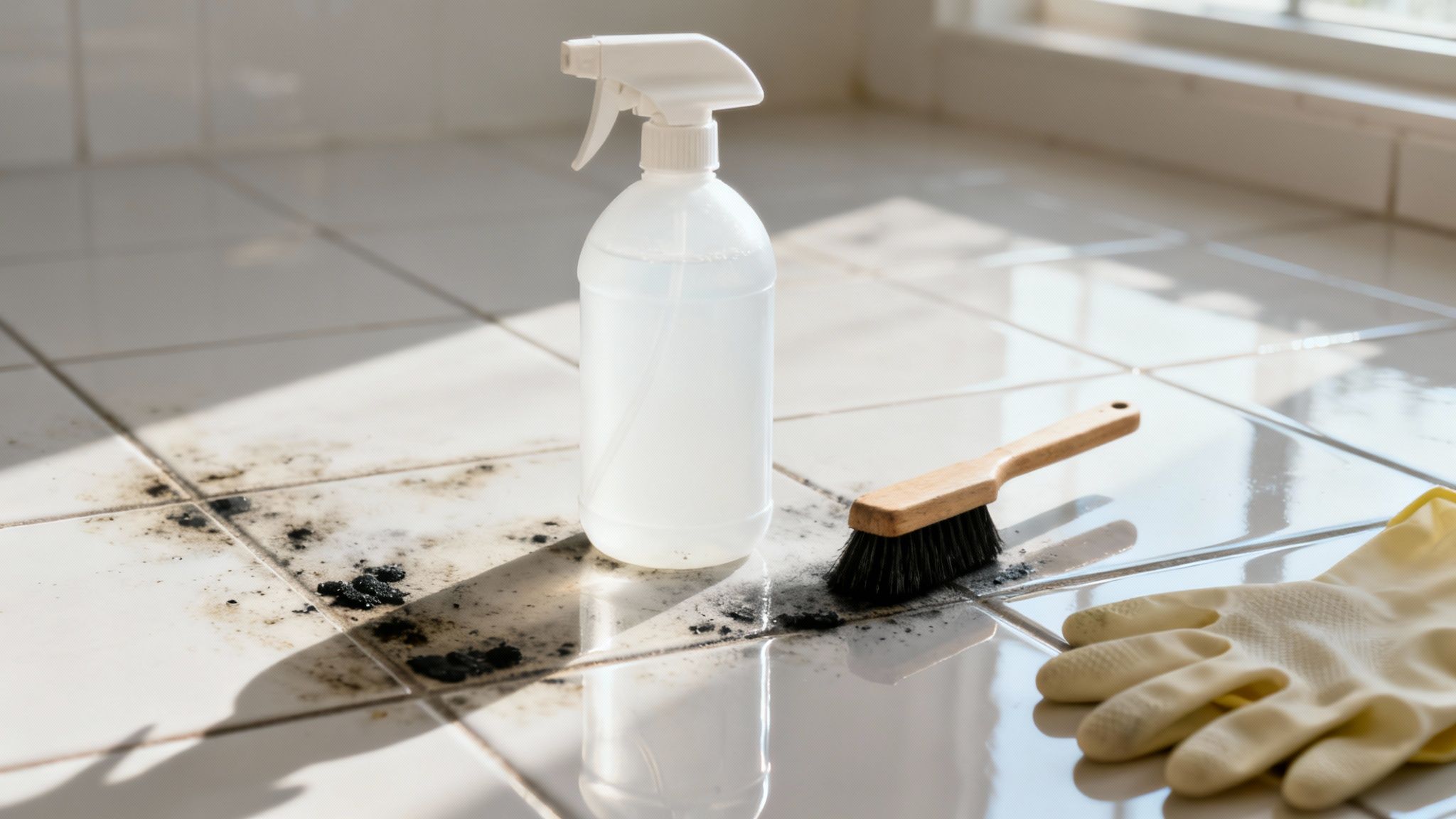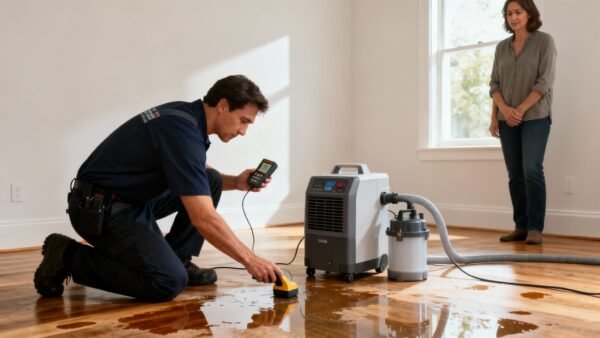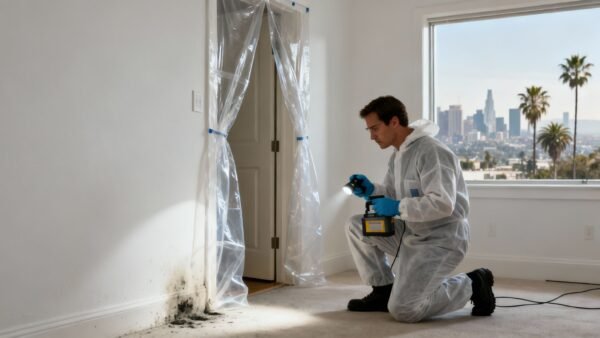When you spot ugly black mold in a damp corner of your home, like a bathroom in Santa Monica affected by coastal fog or a leaky flat roof in Sherman Oaks, your first instinct might be to grab a bottle of bleach. It feels like the strongest, most logical solution. But does bleach actually kill black mold?
The surprising answer is no—at least not in the way you need it to. While bleach might get rid of the surface stain on non-porous materials like tile, it fails to eliminate the mold’s deep root system in porous surfaces like drywall and wood. In many cases, using bleach on mold can actually make the problem worse over time. This guide breaks down why bleach is the wrong tool for the job and what you should be doing instead.
Ready to skip the DIY guesswork? If you’re dealing with a mold problem in the Los Angeles area, our certified team is ready to help.
The Short Answer: Why Bleach Is a Bad Idea for Black Mold
Reaching for a bottle of chlorine bleach to tackle a mold problem is one of the most common mistakes we see Los Angeles homeowners make. It’s a widespread misconception that often leads to recurring issues and even hidden dangers.
Think of it like pulling the top off a weed but leaving the root intact. You know what happens next: the problem is guaranteed to grow back, sometimes even stronger than before.
This infographic shows what’s really happening when you spray bleach on a porous surface like drywall. It’s only cleaning the surface.
As you can see, the bleach only touches the visible mold. It leaves the underlying root structure completely untouched and ready to regrow.
Why Bleach Is an Ineffective Solution
The core of the problem is that bleach is mostly water. Its active ingredient, sodium hypochlorite, simply can’t penetrate porous materials like wood or drywall where the mold’s roots (called mycelium) are deeply embedded.
Here’s what happens when you apply bleach:
- The chlorine quickly gasses off and evaporates from the surface.
- The water component soaks deep into the material.
- This leftover moisture ends up feeding the surviving mold roots, actually encouraging them to grow back.
It’s why the U.S. Environmental Protection Agency (EPA) specifically cautions against using bleach for routine mold cleanup. Because black mold (Stachybotrys chartarum) roots itself so deeply into building materials, bleach fails to reach and kill the entire organism. All it does is provide a temporary cosmetic fix.
Bleach for Black Mold: A Quick Comparison
To put it in perspective, here’s a quick breakdown of how bleach performs on different surfaces.
| Factor | Bleach on Non-Porous Surfaces (Tile, Glass) | Bleach on Porous Surfaces (Drywall, Wood) |
|---|---|---|
| Surface Cleaning | Effective. Removes visible stains. | Temporarily Effective. Removes surface stains but leaves roots behind. |
| Root Penetration | Not Applicable. Mold cannot root into these surfaces. | Ineffective. The active ingredient evaporates before it can penetrate. |
| Long-Term Risk | Low. Kills surface mold effectively. | High. The water content feeds the remaining roots, encouraging regrowth. |
| Safety | Moderate Risk. Fumes are toxic; mixing is dangerous. | High Risk. Fumes are toxic, and the false sense of security allows mold to thrive unseen. |
As the table shows, bleach’s usefulness is incredibly limited. While it might seem to work on a hard, sealed surface, it’s the wrong tool for the job on the materials where serious mold problems take hold.
This superficial approach creates a false sense of security while the mold continues to thrive just beneath the surface. For truly effective and safe solutions, you need to understand the right way to handle it. You can explore our expert mold removal tips for safer, more reliable methods.
In the sections to come, we’ll dive deeper into the science behind why bleach fails and what you should be doing instead to protect your home and your health.
The Science: Why Bleach Fails to Eliminate Mold Roots
To understand why bleach is the wrong tool for the job, you have to get a picture of how mold actually grows and how bleach works. There’s a huge misconception that a harsh chemical like bleach will nuke any fungus or germ, but the science tells a totally different story.
Think of a mold problem like an iceberg. Those ugly black spots you see on the drywall? That’s just the tip. Underneath the surface, a massive, tangled network of roots—called mycelium—is digging deep into porous materials like wood, grout, or drywall. That hidden root system is the real engine of the mold colony.

The Chemical Mismatch on Porous Surfaces
Bleach’s main ingredient, sodium hypochlorite, has a high surface tension. That’s just a scientific way of saying its molecules cling tightly to each other instead of soaking into things. Because of this property, it’s physically impossible for bleach to penetrate porous materials.
So when you spray bleach on a moldy wall, the chlorine just sits on top, basically bleaching the color out of the visible stain. Meanwhile, the mycelium network buried deep inside the material is left completely unharmed, just waiting for the right moment to grow back.
It’s not just our opinion. Both OSHA and the EPA officially state that bleach should not be used for mold remediation on porous surfaces. Its inability to reach and kill the roots makes it a useless long-term solution.
How Bleach Can Actually Feed Mold
Here’s the kicker, and it sounds completely backward: using bleach can actually make your mold problem worse. Household bleach is mostly water—about 90% water, in fact.
When you douse a moldy wall with it, here’s what really happens:
- The chlorine gas evaporates almost immediately. After a few minutes, its sanitizing power is gone, leaving a clean-looking surface.
- The water component soaks right into the drywall. This moisture travels deep into the material, delivering a drink directly to the untouched mold roots.
- The roots absorb the water and thrive. You’ve essentially just watered your mold, giving it the fuel it needs to come back even stronger.
This vicious cycle is why so many people get frustrated when mold reappears in the exact same spot weeks later. You didn’t kill it; you just hid the stain and fed the colony. If you suspect the problem goes deeper than what you can see, our guide on hidden mold behind walls explains what to watch for.
Non-Porous vs. Porous: A Critical Distinction
Now, to be fair, bleach does have its place. It can be very effective at killing surface mold on hard, non-porous materials like glass, sinks, tubs, or sealed tile. On these surfaces, mold can’t grow roots, so all you need to do is kill what’s on top.
But the vast majority of serious black mold infestations happen on porous materials where moisture has gotten trapped. Trying to use bleach here is a total mismatch. You’re not solving the problem, you’re just hiding it.
The Hidden Dangers of Using Bleach for Mold
Trying to tackle a mold problem with bleach is one of those classic home remedies that seems to make sense, but it often ends up creating an entirely new set of hazards. Beyond the fact that it just doesn’t work on porous surfaces, using bleach introduces some serious health and safety risks that most people don’t see coming. This is why the real answer to “does bleach kill black mold?” has to include the collateral damage.
The most immediate danger is the fumes. Bleach lets off some incredibly harsh volatile organic compounds (VOCs) that can burn your lungs, eyes, and throat. This gets even riskier in the exact places mold loves to grow—poorly ventilated basements, bathrooms, and cramped closets.
Respiratory Risks and Toxic Fumes
When you open that bottle of bleach, you’re essentially releasing chlorine gas into your home’s air. For anyone with asthma, allergies, or other breathing issues, those fumes can trigger a serious reaction. Even if you’re perfectly healthy, long exposure can lead to coughing, shortness of breath, and chest pain.
But the situation can get much, much worse if bleach accidentally mixes with other common household cleaners.
- Bleach + Ammonia: This is a recipe for toxic chloramine gas. Inhaling it can cause severe respiratory tract damage, fluid in the lungs, and can even be fatal.
- Bleach + Rubbing Alcohol: This combo creates chloroform, which is highly toxic.
- Bleach + Acidic Cleaners (like toilet bowl cleaner): This reaction produces pure chlorine gas, the same chemical used as a weapon in World War I.
The chemical toxicity alone makes bleach a poor choice, especially in homes with kids or pets who are more sensitive to these fumes. You can learn more about why bleach is a risky choice for mold from My Mold Masters.
The Lingering Threat of Dead Mold Spores
Let’s imagine for a second that bleach did manage to kill the surface mold. There’s still another hidden danger left behind: the dead mold fragments and spores. These microscopic particles are still allergenic and toxigenic, meaning they can continue to trigger allergic reactions and health issues long after the visible stain is gone.
Simply killing the mold is not enough. To truly solve the problem and protect your health, all mold-contaminated materials must be physically contained and removed from the property. Leaving dead spores behind is like leaving dust and pollen in the air—it will still cause a reaction.
This is the key difference between a DIY cleanup and professional remediation. Professionals focus on complete removal, not just wiping a surface. The health risks tied to mold exposure don’t just vanish because the color changed. You can read more about why complete mold removal is so important for Los Angeles homes in our detailed guide.
When you add it all up, the dangers of using bleach far outweigh any temporary “benefit,” making it an unsuitable and hazardous choice for any real mold issue.
Why Black Mold Demands a Different Strategy: Removal, Not Bleach
When you see black mold, you’re not dealing with your typical shower mildew. This stuff, known in scientific circles as Stachybotrys chartarum, is a whole different beast. It’s notorious for one big reason: it produces mycotoxins, which are toxic compounds that can create serious health risks. That fact alone shifts the job from simple cleaning to a non-negotiable safety mission.
Dealing with black mold isn’t just about aesthetics; it’s about protecting your health. The goal isn’t to make a stain disappear. It’s a three-part process: safely contain the mold, physically remove every bit of contaminated material, and—most importantly—fix the moisture problem that let it grow in the first place.
The Goal is Removal, Not Just Killing
Here’s the single biggest mistake homeowners make: they think the goal is just to “kill” the mold. This leads them straight to the bleach bottle, but that’s a purely surface-level fix. Black mold is like a weed with deep roots (called mycelium) that burrow into porous materials like drywall, wood studs, and insulation.
Proper remediation is about total physical removal. You can’t just spray something on a wall and hope the roots inside die off. A professional will cut out the entire contaminated section and dispose of it using strict safety protocols. This guarantees no hidden mold is left behind to regrow and ensures that even dead mold particles, which can still trigger allergies, are gone for good.
The core principle in professional mold remediation is source removal. Just killing what you can see is a cosmetic patch-up. Real safety comes from eliminating the mold, its hidden roots, and the moisture that feeds it.
Understanding Mycotoxins and Health Risks
What really sets black mold apart is its ability to produce those nasty mycotoxins. These microscopic compounds are easily disturbed, becoming airborne and circulating through your home. Black mold produces harmful mycotoxins linked to respiratory problems, skin irritation, and other health effects, making its complete removal critical for safety. And here’s the kicker: bleach only kills mold on the surface and doesn’t get into the porous materials where the mold’s roots are hiding. You can find more details about the limitations of bleach on bustmold.com.
This is precisely why a specialized approach is so critical. Pros use containment barriers and negative air pressure machines to stop these toxins from spreading during the removal process. Trying to handle it yourself with a bottle of bleach not only fails to solve the root problem but can actually make things worse by disturbing the colony, launching a cloud of spores and mycotoxins into your air. This invader requires a real strategy built on containment and removal, not just a splash of a cleaning agent.
Safer DIY Methods: What to Use Instead of Bleach
So, we’ve established that bleach is the wrong tool for the job. Now for the good news: you probably already have safer, more effective solutions right in your pantry for small, manageable mold spots.
These alternatives work because they can actually penetrate porous surfaces and get to the mold’s roots, all without the harsh fumes. For minor issues—think less than 10 square feet—on surfaces that aren’t falling apart, these DIY methods can be a great first step.
Just remember, safety first. Always gear up with an N-95 mask, goggles, and gloves, no matter which option you choose.

Distilled White Vinegar
Unlike bleach, distilled white vinegar is a mild acid. That property is its secret weapon—it allows the vinegar to seep into porous materials like drywall and wood to kill the mold’s root structure, the mycelium. Studies have shown it’s surprisingly effective against many common mold species, making it an excellent non-toxic choice.
How to Use It:
- Pour 5% distilled white vinegar straight into a spray bottle. Don’t water it down, or you’ll weaken its power.
- Spray the moldy area until it’s completely saturated.
- Let it sit for at least an hour. This gives the acid time to work its magic.
- Scrub the spot with a stiff brush to lift the surface mold, then wipe it clean with a damp cloth.
- Let the area dry completely. The vinegar smell will fade as it dries.
Simple Soap and Water
Sometimes, the simplest approach is the right one. The true goal of mold remediation isn’t just killing the mold—it’s physical removal. A good scrub with detergent and water is fantastic at lifting mold spores and their branching structures (hyphae) right off the surface.
The core principle of mold remediation isn’t about killing the mold with a chemical agent; it’s about physically removing the contamination. Soap and water, combined with vigorous scrubbing, accomplishes this by breaking the mold’s bond with the surface and lifting it away.
Hydrogen Peroxide
If you need a bit more punch than vinegar, 3% hydrogen peroxide is a solid option. It’s an antifungal, antiviral, and antibacterial agent that kills mold dead. As a bonus, it has a natural bleaching effect that can help lighten any stains the mold left behind.
Comparing Mold Cleaning Solutions
Choosing the right cleaner depends on the surface you’re dealing with and your comfort with different chemicals. This table breaks down the pros and cons of common go-to solutions.
| Solution | Effectiveness on Porous Surfaces | Safety Risks | Best For |
|---|---|---|---|
| Bleach | Poor. Only kills surface mold. | High. Toxic fumes, skin irritation. | Non-porous surfaces like tile and glass. |
| Vinegar | Excellent. Penetrates and kills roots. | Low. Mild acid, strong odor. | Porous materials like drywall and wood. |
| Hydrogen Peroxide | Good. Kills mold and removes stains. | Moderate. Can cause skin/eye irritation. | Stained surfaces and general mold killing. |
| Soap & Water | Good for Removal. Lifts mold off surfaces. | Very Low. Standard cleaning precautions. | Initial cleanup and non-porous surfaces. |
Ultimately, while bleach might look like it’s working, vinegar and hydrogen peroxide are far better at getting to the root of the problem on porous materials. For simple surface cleaning, you can’t go wrong with basic soap and water.
A Quick Note on DIY Limits
These methods are designed for small, contained areas of surface mold. If you see mold covering a large area, if it comes back after cleaning, or if you can’t shake a strong musty odor, you’re likely dealing with a bigger problem.
Widespread contamination requires professional gear like HEPA vacuums and specialized air scrubbers to trap airborne spores. If your situation feels overwhelming, looking into an air scrubber rental for mold remediation can give you the professional-grade air purification needed to tackle the job safely. When in doubt, always call a professional.
Knowing When to Call a Mold Remediation Professional
It’s one thing to wipe a small mildew spot off your shower tile. It’s another thing entirely to face a true mold infestation. Knowing the line between a quick DIY cleanup and a job that absolutely requires an expert is crucial for protecting both your home and your family’s health.
Ignoring the warning signs can lead to widespread structural damage and persistent health issues. The real goal is to solve the problem for good the first time, not to get stuck in a frustrating cycle of cleaning the same spot every few months.
When to Put Down the Spray Bottle
A certified professional should be your first and only call if you run into any of these situations. These aren’t just cosmetic issues; they’re clear red flags that the mold problem is much bigger than what you can see on the surface.
- The Mold Covers a Large Area: If you see a patch of mold bigger than 10 square feet (think a 3-foot by 3-foot square), the U.S. Environmental Protection Agency (EPA) says it’s time to call in the pros. A patch this large almost always signals a significant, ongoing moisture problem that needs to be fixed.
- A Strong, Persistent Musty Odor: Can’t see much mold but can’t shake that damp, earthy smell? That’s the classic calling card of a hidden colony. It’s likely thriving behind your walls, under the floorboards, or deep inside your HVAC system where you can’t reach it.
- Mold Appears After Water Damage: If you’re dealing with mold after a flood, a burst pipe, or a serious roof leak, you can bet the contamination is soaked deep into your home’s structure. Water-logged drywall, insulation, and wood framing are the perfect breeding grounds for mold and require professional equipment to handle safely.
- You Have Health Concerns: Is someone in your house dealing with unexplained allergies, breathing problems, or other chronic symptoms? Don’t take chances. Bringing in an expert is essential to make sure your home’s air quality is safe for everyone.
The Professional Remediation Process
When you hire a certified team, you’re not just getting a cleaning crew. A real mold remediation service is a systematic, science-backed process designed to safely contain and remove the contamination—and stop it from ever coming back.
The heart of professional remediation isn’t just about scrubbing surfaces; it’s about containment and source removal. Experts use physical barriers and negative air pressure machines to completely isolate the work area. This is a critical step that prevents billions of microscopic spores from spreading through the rest of your home during the removal process.
A professional team will find and fix the moisture source, use powerful HEPA air scrubbers to capture airborne spores, and safely bag and remove all contaminated materials. This is how you solve a mold problem at its root.
Frequently Asked Questions About Mold and Bleach
Let’s wrap things up by tackling some of the most common questions people have about using bleach on mold. Think of this as a quick-reference guide to bust a few myths and reinforce what actually works. My goal here is to clear up any lingering confusion so you can handle mold issues safely and effectively.
Q: What should I do if I already used bleach on mold?
A: First, don’t panic. If you’ve already used bleach, the most important thing to do now is get the area completely dry. Use fans or a dehumidifier to remove all leftover moisture from the material. Then, monitor the spot for a few weeks. If the mold returns, you’ll know the bleach didn’t reach the roots, and it’s time to call a professional for a proper assessment.
Q: Does bleach kill all types of mold?
A: No. Bleach can kill surface mold on hard, non-porous materials like glass or sealed tile, regardless of the mold type. However, it is ineffective on porous surfaces like drywall, wood, or grout because its chemical structure prevents it from penetrating to the mold’s root system (mycelium). The type of mold doesn’t change this fundamental limitation.
Q: Can using bleach actually make a mold problem worse?
A: Yes, absolutely. Household bleach is about 90% water. When applied to porous surfaces, the chlorine component quickly evaporates, leaving the water behind. This water soaks into the material and provides moisture to the surviving mold roots, essentially feeding the colony and encouraging it to grow back, often stronger than before.
Q: Is it ever safe to mix bleach with other cleaners?
A: No, never mix bleach with other cleaning products. Combining bleach with ammonia-based cleaners creates toxic chloramine gas, while mixing it with acidic cleaners (like toilet bowl cleaner) can release chlorine gas. Both are extremely hazardous to your respiratory system and can be fatal. The answer to “does bleach kill black mold” is already no, and trying to boost its power only creates a dangerous chemical risk.
If you’re staring down a mold problem in your Los Angeles home that feels too big to handle, don’t waste time on myths and solutions that don’t work. The IICRC-certified experts at Onsite Pro Restoration have the right training and professional-grade equipment to get rid of mold for good, safely and permanently.
Protect your property and your health. Let our team give you a clear path forward with a free assessment today.





